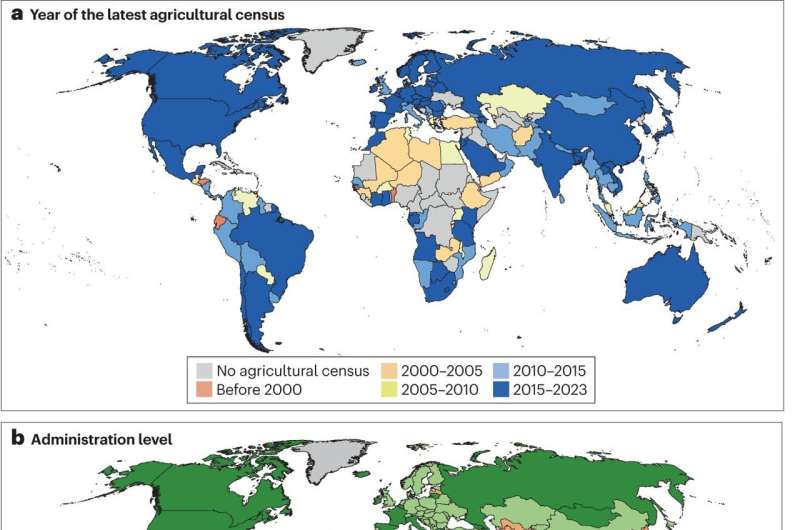This article has been reviewed according to Science X's editorial process and policies. Editors have highlighted the following attributes while ensuring the content's credibility:
fact-checked
peer-reviewed publication
trusted source
proofread
Study looks at challenges facing global food production data

To understand the food production resources necessary to help feed a growing global population, accurate and up-to-date data, such as crop, livestock, aquaculture and fisheries statistics, are crucial for the implementation of effective food system interventions.
A study from the University of Delaware that took stock of national and international food production data to understand its availability and limitations, however, found that across food production databases, there were substantial global variations in data timeliness, granularity—or the level of detail, both spatially and by food category—and transparency.
The paper was published in Nature Reviews Earth & Environment.
Endalkachew Kebede, a doctoral student in the Department of Geography and Spatial Sciences in UD's College of Earth, Ocean and Environment, served as the lead author on the paper. Kebede is in the lab group of Kyle Davis, an assistant professor in the Department of Geography and Spatial Sciences and the Department of Plant and Soil Sciences, as well as a resident faculty member with UD's Data Science Institute. Other co-authors from Davis' lab, in addition to Davis himself, include Hanan Abou Ali and Piyush Mehta, both doctoral level students.
Kebede said that having accurate, comprehensive and timely food production data is crucial to identify the regions of the world where it is necessary to plan and implement food security initiatives.
"Food production is a huge part of global sustainability, and because of this, data availability has huge implications in terms of food security and water sustainability worldwide," Kebede said.
The realization of the need for up-to-date and accurate data came about when Kebede and Mehta were working on a different project—one focused on global irrigation mapping.
That process involved painstaking and laborious work, with the two going to individual country's websites and contacting agricultural ministry officials, as well as looking at different databases to try and compile all the available agricultural statistics from all possible sources.
"We started with international agencies such as EUROSTAT, which contains data for Europe and European Union states, and Food and Agriculture Organization (FAO) STAT which contains all countries but under different administrative levels," Mehta said.
"Nationally, we started with FAOSTAT and then we went to individual countries' agricultural census websites and irrigation censuses websites, anything that we could find. We would also go to a country's national website and extract whatever data they had, whatever format and language it was in, and then repeat the same process for each country and geo-pool all the information."
It soon became clear that the data for different food products, over different time periods, and at different levels of spatial detail varied from country to country.
In particular, the primary sources of food production data are large-scale censuses, comprehensive data-gathering efforts meant to occur every five or 10 years, or surveys—more frequent and less intensive sampling, with complementary remote sensing, such as satellite-based efforts being employed in certain countries. But not every country has the resources or personnel to fund, implement and execute these comprehensive data collection efforts regularly, or the ability to standardize, store and make the data freely available.
In the paper, the researchers looked at crop production, livestock, fisheries and aquaculture, finding that the livestock, fisheries and aquaculture sectors have the most pronounced data scarcity at both the national and local level.
With regard to fisheries, the wide-ranging, mobile and relatively invisible nature of these practices makes accurate and consistent fisheries data collection challenging, time-intensive and costly, while the ability to capture accurate livestock data is prohibited by cost, reliability and reproducibility.
In addition, certain parts of the globe struggle to produce accurate and up-to-date data.
"In terms of data availability and quality, most of the data scarcity has been observed in those developing regions such as Central America, sub-Saharan African countries, North Africa and some parts of Asia, with the exception of India and some other countries which have a significant data quality," Kebede said. "In those developing countries, they may have challenges related to inadequate financial and human resources available for an agricultural census."
This is a concern because a lot of the areas that have a scarcity of reliable agricultural data are also those facing acute food insecurity challenges and a need to rapidly increase food production.
"Ultimately, we're interested in increasing food production, doing it sustainably and making sure that food production is well adapted to climate change," Davis said.
"If you want to have targeted interventions that realize the largest benefits, you need to have confidence that you're providing an accurate spatial representation of where those activities are happening."
"That is fundamentally why the data scarcity issue is so important. If you don't have reliable underlying agricultural statistics, then you can't, with confidence, say that this crop or this animal or this fish product is being produced in this particular place. And then you can't reliably say, 'This is where an intervention should take place.'"
More information: Endalkachew Abebe Kebede et al, Assessing and addressing the global state of food production data scarcity, Nature Reviews Earth & Environment (2024). DOI: 10.1038/s43017-024-00516-2
Journal information: Nature Reviews Earth & Environment
Provided by University of Delaware





















